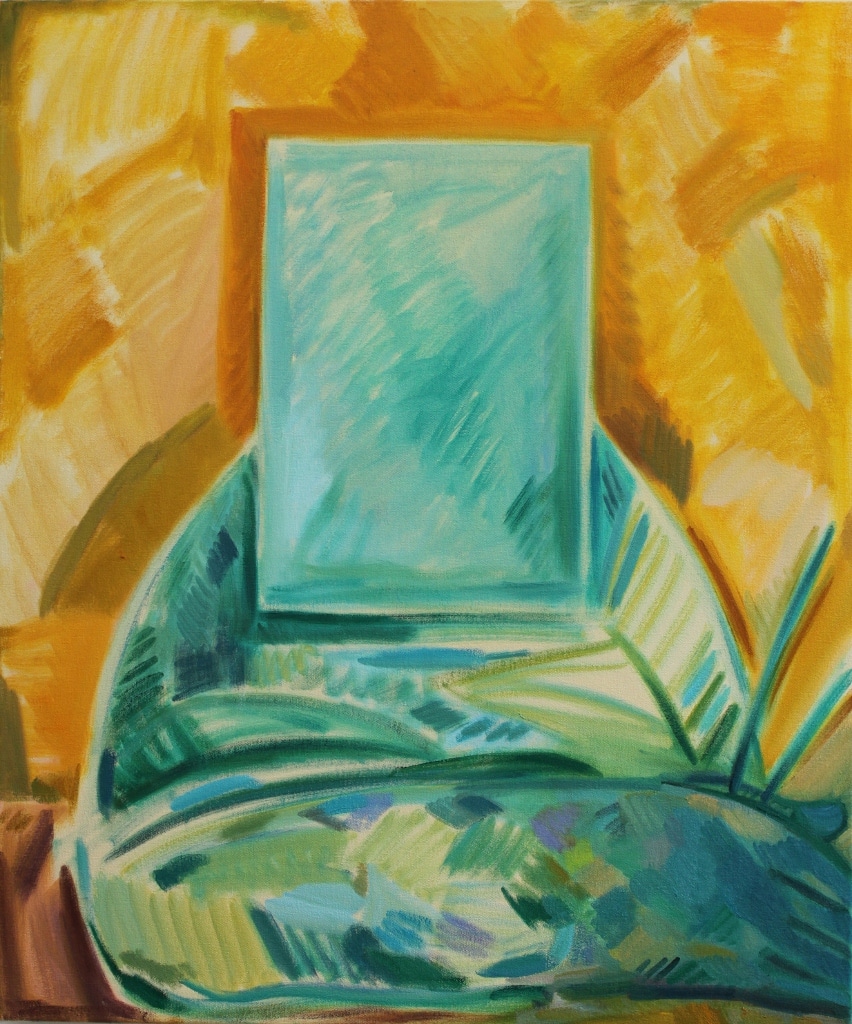
Kiera Bennett, The Painter, 2013 oil on canvas 90x75cm
Instantly recognisable in Kiera Bennett’s paintings are the trappings and tropes of early modernism: the feathered lines of early cubism/late Cézanne, the vibrating geometry of Boccioni or Carrá, the pulsing colours and tabletop domesticity of early Matisse. There are two things that, despite these allusions, Bennett’s paintings aren’t. One, they’re not exercises in art historical nostalgia; two, they’re not sarcastic citations of early modernism, as has been commonplace in recent art. Instead, they hover between reverence and critique, refusing to settle on a fixed position, and in doing so embody a certain attitude about the art of the past: that it’s always there, called back in any act of painting, whether you like it or not. Bennett’s paintings can’t quite decide how they feel about that. The equivocation is all.
This refusal to commit is part of the subject matter of the paintings, too. Figures, when they appear, are always fragmentary, as though glimpsed: they can’t decide to stay or go. Hitchcockian profiles blow smoke rings that are as substantial as they are; hands, arms and backs are described in lines that seem to lose their pictorial moorings and drift away. This condition of being not-quite-there is part of Bennett’s arms-length separation from the modernist ancestors from whom her turns of phrase derive. Inverting the cubist faith in painting’s unique ability to embody the shattered stuff of modern culture, Bennett’s paintings occupy a shifting territory between that confidence and its opposite. Death-haunted as all contemporary painting is – aware of its own anachronistic status in contemporary image-making, and mindful of repeated pronouncements of its demise – these works proceed cautiously, their embodied uncertainty part of what gives them particular force and strength.
Bennett’s work ‘The Painter’ introduces a recurrent theme in the artist’s recent paintings: the image of an artist. The title alone, redolent of a master of disguise’s current incarnation, or bit-part in a play’s cast, carries with it associations of stylistic ventriloquism of a piece with Bennett’s practice as a whole. A figure faces out from the painting’s space, clutching loosely rendered paintbrushes in one fat hand, its face obscured by a rectangular panel. Portraiture’s traditional revelatory function is flipped, here, in a manner reminiscent of Roy Lichtenstein’s 1976 ‘Self Portrait’, which replaces the artist’s face with a mirror. (This is mirror-like, too, with its scuffed tonality and dimly reflected light). And yet Bennett’s painting isn’t even a portrait: it’s a bit of painterly play-acting, fending off a portrait’s claims to truth with allusive sleights-of-hand that make you question what it is you’re actually seeing. Did ‘The Painter’ paint this, or Bennett? Are those dry striations hers or his? In Bennett’s hands, a painting is a site of mudded possession, the painted lines patter in a hammy old stage act, each one a mark of misdirection.
In ‘Painting’, Bennett’s ‘Painter’ is caught in the act, his arm held aloft in dynamic creation, high modern forms spiralling from his brush’s touch. (About that ‘his’: it does seem to be a male modernist she’s channeling, with all the associations of masculine heroic endeavour some early modernism, especially cubism, celebrated). Conflating wand and brush, Bennett recasts the modernist as end-of-the-pier magician, both shyster and enchanter. And when, in ‘Studio’, we see the artist only as a series of shorthand curves – elbow, hunched back, head – the maker and the work are one: he disappears into the painted world. There’s something here about modernism’s sublimation of style to personality, or to the modernist painter’s reshaping of the world in his own image (and that brush-wielding hand does carry distant memories of Michelangelo’s Sistine God), but, as always, Bennett’s conveyance is both allusive and sensually immediate. Her palette – blanched ochres, pinks and pea-greens, enlivened by fizzing complementaries – runs against any sense of post-modernist winking or nudging, saving it from being art about art. ‘Poisoned’, for instance, pits lemon yellow zigzags against thinly rendered purples, oranges and greens; it’s both a performance of its title (acid colour as a malign contaminant of the painted object) and a riff on Bennett’s own stylistic contamination with the visual language of the century gone. And yet its colouristic combinations belong to a contemporary sense of distant time. It hums with a buried heat, recoverable, perhaps, in the act of painting. Bennett’s works enact contemporary painting’s agnostic half-belief: that painting’s communicative powers might never diminish, regardless – perhaps even because – of the exhaustion of its box of tricks.
- Written for show of Kiera Bennett at Charlie Smith Gallery, London, April 2013